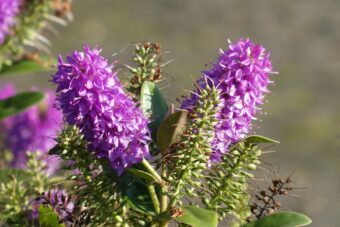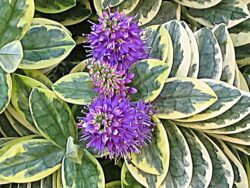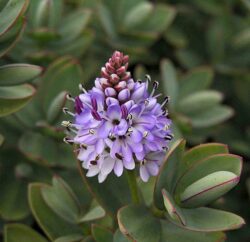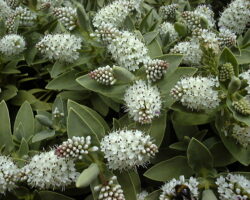In this article, we will discover how Hebes can be successfully grown in containers. In the UK, you will notice Hebes in many gardens, but not so often grown in containers. You wonder is it possible to do so and in this article, I will show you how.

Hebes are plants that come from New Zealand, but most plants nowadays come from South America and Australia. They are showy plants best displayed in a predominant position.
People want to grow Hebes for two reasons; the colourful leaves that they have and the mid to late summer flowers that they produce. The flowers are produced en masse but they come with a price that most of them are borderline hardy, taking a temperature no lower than minus 5 degrees Celsius.
It is advised to grow small-leaved varieties in containers, but if you grow large-leaved species that you cover them with horticultural fleece to protect them from cold frosts in hard winters. Most container-grown species will not grow more than 90cm in height.
HOW TO GROW HEBES IN CONTAINERS
You can pot Hebes in containers any time of the year, but it is better to plant them during the growing season. This will allow ample time for the Hebe to form a strong root system before it is exposed to the cold and will give it a chance to form a strong and sturdy plant.
Use a 30cm diameter container or more depending on the size of the plant will get to and fill it with a mixture of 70% multipurpose compost by volume and 30% by volume of horticultural grit. This will ensure that the growing media is free-draining, avoiding potential loss due to overwatering.

Dig a hole that is twice the size of the original root ball and place the plant in it. Start to backfill, ensure the level is the same as the level it was in the original pot- not shallower or deeper. Fill any gaps with more compost and firm the plant in. Water it in and make sure that in the first year of growth that it is well watered. This will make sure that the plant will establish quickly and healthily.
As they tend to be quick growing, you may need to repot every year or two, depending on the species that is planted.
Every spring give a feed of slow-release fertiliser to give a boost for the forthcoming growing season. Keep well-watered, especially so in hot summers, but make sure the growing media is never soggy. Water when 5cm below the top of the surface of the compost feels dry to the touch when you stick your finger in.
HOW TO PRUNE HEBES

Hebes shrubs will grow leggy over time, which will give an unsightly look. This is why you will need a regular pruning regime in mid-spring. At this time, you will need to shear lightly to improve the look and to help it bush out and produce new, healthy shoots.
Hebes, in general, are short-lived, lasting no more than 10 years in pots. This is why pruning is essential, as described above. It is also important to deadhead the shrub as this will help to extend the flowering period. If your Hebe has become too straggly, you can cut it to within 30cm of the ground as this will lead the plant to rejuvenate and have better new growth.
VARIETIES TO GROW
As you can imagine there are so many varieties of Hebe to grow and the following are some of the most recommended:
Hebe x franciscana ‘Variegata’ is a fine plant with its large, glossy, cream-edged leaves and it is famed for producing scattered purple-pink flowers.
Hebe ‘Blue Clouds’ has dark green, lanced shaped leaves and dark purple flowers. It produces two flushes of flowers in June and July and once again between September and December. A short Hebe only growing up to 1m in height.

Hebe ‘Nicola’s Blush’ has grey, green leaves whose edges are red in colour. In summer, purple tints are noted along with pale pink flowers that appear en masse. This is a very short Hebe only growing up to 60cm in height,
Hebe ‘Great Order’ has green, long, lance-shaped leaves and in summer bright, pink flowers appear all over the plant. Will grow up to 1.4m in height.
Hebe albicans is a small evergreen shrub that blooms in early summer, with white flowers emerging from pink buds. The grey-green foliage is evergreen, associating beautifully with silver foliage plants and making a great addition to white planting schemes.
Hebe cupressoides ‘Boughton Dome’ has small bright green leaves and a small compact growing habit.
Hebe ‘Red Edge’ has stately grey-green leaves with red-pink margins. A plant that is grown for its leaves and not much so for its flowers.
Hebe ‘Rhubarb and Custard’ has a dense, bushy habit formed of pink-tinged cream and green leaves, it certainly has the sugary hues of the popular pudding.
Hebe ‘Pascal’ is a plant that has green leaves in summer but in winter these same leaves turn a fiery red. This and the beautiful blue and lilac flowers make it a desired shrub. As it only grows up to 50cm in height, it will make it an ideal choice for containers.
Hebe ‘Wild Romance’ is a delight with new growth at the stem tips that is cerise pink in late spring, creating a bold contrast with the mature cream and green leaves lower down the stems. As winter approaches, the leaves darken to rich maroon-red.
Hebe ‘Midnight Sky’ is a handsome variety with glossy evergreen foliage that turns bronze-black in winter. In warmer weather, the foliage is dark green making a fine backdrop for its mauve purple flower spikes, which are borne freely throughout summer.
Hebe ‘Starlight’ will dazzle you with its stunning good looks! In summer, the silvery-green variegated foliage shows off the gleaming white flowers to perfection.
Hebe ‘Silver Anniversary’ is an elegant evergreen shrub that is grown for its beautiful variegated foliage and contrasting purple stems. The slender leaves are grey-green with irregular, silvery margins. Cold winter weather brings about a gentle purple tint that makes a lovely feature when there are little other colours in the garden.
The plants themselves tend to not suffer from pests or diseases. Making them ideal choices for those who wish to grow organically.
CONCLUSIONS
In this article, we have discussed how to get the best from your container grown Hebes, how to plant them and what care will be required. They are in general easy plants to care for, only needing to be fed in spring with a slow-release fertilizer, watering in dry weather and pruning in spring to keep it neat and tidy. As you can imagine from a large genus of shrubs, you will have plenty of choices but in this article, some of the more elegant varieties have been suggested.
If you have any questions or comments that you wish to make on growing Hebes in containers, please do so in the comment box below.
Happy Hebe growing.
